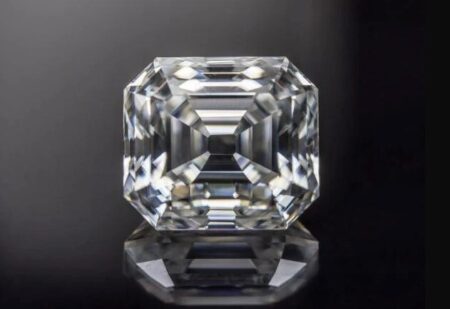In this brief guide to the loose diamond Asscher cut, we will cover the following topics:
- What is an Asscher cut diamond?
- The history of the Asscher cut
- Are Asscher cut diamonds more expensive than standard cuts?

In this brief guide to the loose diamond Asscher cut, we will cover the following topics:
An Asscher cut diamond is an octagonal diamond with a square shape and layered facets. The Asscher cut features a deep pavilion and high crown and is prized for its antique appearance. The design of this cut accentuates its clarity for optimal brilliance.
Its straight-edged facets have the same length and width. Its four corners are bevelled, creating an additional four sides that mimic the shape of an emerald cut. However, the difference lies in its square shape, whereas the emerald cut boasts an elongated design.
There are two types of loose diamond Asscher cuts: the standard Asscher cut and the Royal Asscher cut, both of which were created by the Royal Asscher company.

The Asscher cut diamond was invented in 1902 by Joseph Asscher, the artisan diamond cutter who founded the I.J Asscher Diamond Company, today known as the Royal Asscher Diamond Company.
It was the first patented diamond cut and became a staple of art deco jewellery, with its sleek straight lines, stunning brilliance and bold shape.
Edward and Joop Asscher set out to improve their great-grandfather’s cut and created the Royal Asscher cut diamond in 2001. Thanks to modern diamond cutting technology, the brothers were able to improve on the accuracy of the cut and add facets, resulting in a diamond that reflected more light, than the standard cut.
Generally, the price per carat for an Asscher loose diamond tends to be slightly lower than other cuts.
There is much less waste with Asscher cut diamonds compared to other cuts, as they use a large percentage of rough diamond (approximately 65-75%). The diamond also holds more carat weight distribution in the centre of the diamond, making them look visually smaller than round cut diamonds of the same carat weight. For instance, a round cut diamond with 1.00 ct weight will be about 6.4 mm, whereas the Asscher cut will be 5.5 mm.
You can, therefore, expect to pay less for an Asscher cut, even when other factors are the same.
Regardless, you must always use the 4 Cs to guide your purchase and ensure you make the best investment choice.
Are you interested in buying Asscher cut loose diamonds as a value investment, at a very attractive price? The experts at BNT Diamonds will be happy to advise you. Contact us by email or chat or contact our team directly on +32 3 201 24 90.